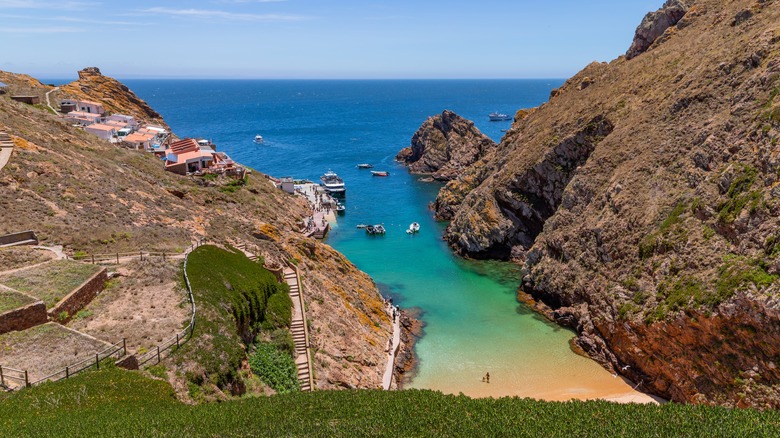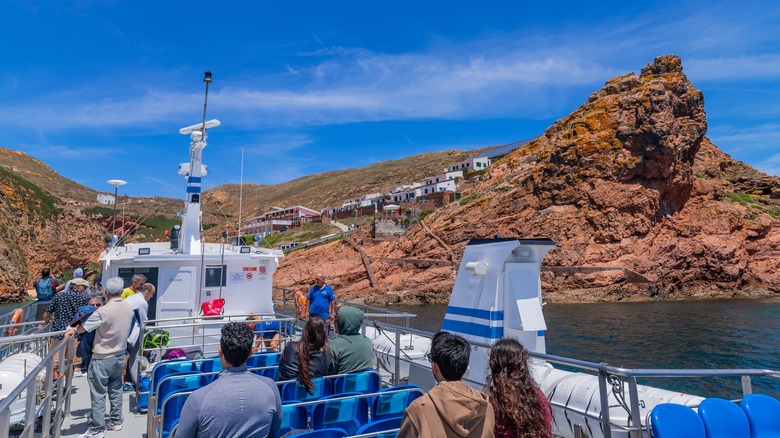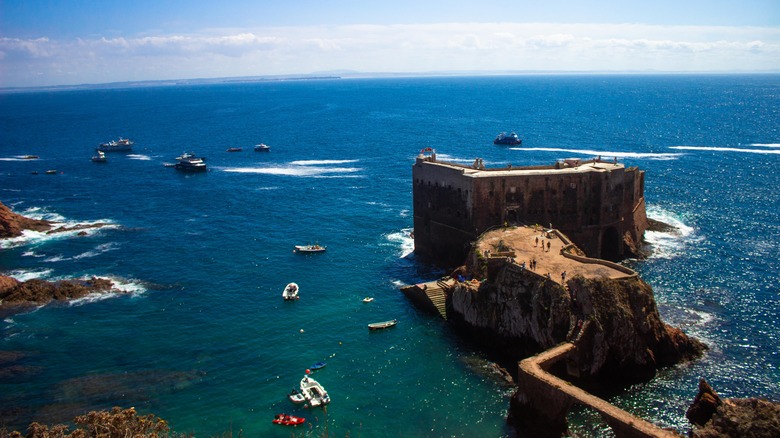One Of Portugal's 'Most Precious Islands' Offers Unmatched Natural Beauty Just 6 Miles From The Mainland
Portugal's sprawling Atlantic coastline offers over 500 miles of hidden coves, rugged cliffs, and golden beaches. Many visitors flock to the sunny shores of the Algarve in the south for some of the most breathtaking beaches in the country. However, Portugal's Silver Coast, known as Costa de Prata, is often overlooked as a destination. Rather than shuttling between Lisbon and Porto, rent a car and explore the coastline between these cities. An hour's drive north of Lisbon, you'll find Peniche, the gateway to the Berlengas Islands. This archipelago is described as one of Portugal's "most precious" for its unique ecosystem that is a UNESCO World Biosphere Reserve.
To protect Berlengas' environment, only a limited number of people per day are allowed to visit the main island of Berlenga Grande. You'll need to reserve a spot for access and pay a small fee. Taking a boat from Peniche is the only way to get there. Several boat operators in Peniche run ferries and tours with a morning drop-off and afternoon pick-up. The ride takes about 30 to 45 minutes, depending on the sea conditions. While it's possible to access the main island year-round, it's best visited when the weather is better from March to October. Be warned: The waters around the Berlenga Islands can be rough. Even seasoned sailors have felt a little queasy on the ride over. It's worth it, though. Berlengas is a place of wild beauty and history. Visitors can climb the rampart of a medieval fort, see the powerful lighthouse that wards off shipwrecks, and swim in the clear waters of its coves and beaches.
What to do on Berlengas Island
All boats dock at Praia dos Pescadores, the fishing village on Berlenga Grande, the only human settlement on the island. There is a visitor's center with a simple restaurant and bathrooms. This is also the place to rent snorkeling equipment or kayaks if you want to explore the sea caves on the island. Right next to it, a cove with a sandy beach and clear water is a great place to rest after the boat ride.
If you're up for a hike, follow the trail that takes you up to the top of the island and the Duke of Bragança Lighthouse. This lighthouse is still working to avert shipwrecks, powered by solar energy, as are all the facilities on the island. Keep hiking and you'll be rewarded with a stunning view of Berlenga's Fort of Sāo Joāo Baptista. This medieval structure has a unique shape to fit the island's peculiar geography. Visitors can cross over the stone bridge to explore inside. Alternatively, you can book a boat tour to take you to the landing area by sea.
Because the archipelago is a protected biosphere reserve, Berlenga is rich in fish and birds, making it a paradise for bird watchers, snorkelers, and scuba divers. Take a kayak to explore the cavernous fringes of the island. Or if you have a diving license, the island's historic shipwrecks are a treasure trove for scuba divers. Whatever you choose to do, keep track of the time to catch your ferry back to Peniche.
Where to Stay and What to Eat on Berlengas Island
Food is limited on the island. The Mesa de Ilha restaurant at the port serves simple lunch menus of fresh seafood. There is also a basic mini market. If you want more options, take along a picnic basket from Peniche, especially extra water for hot days. There are several options to stay on the island, though all accommodations are simple. Mesa da Ilha also has the island's only bed and breakfast with five rooms for guests. Alternatively, you can stay at the Fort of Sāo Joāo Baptista. There's plenty of room, but you'll have to bring your bedding and be ready to share bathrooms and the kitchen. Finally, if you bring a tent, there are a limited number of spaces for camping. Most importantly, bring money. There are no ATMs on the island, and everything is paid in cash.
Once you've seen Berlengas and Peniche, you can keep exploring Portugal's Silver Coast. An hour's drive north is the fishing village of Nazaré, where you'll find North Beach, one of the world's most dangerous beaches. Intrepid surfers often flock there to test themselves against the record-breaking waves. Or head further north to the charming seaside canals of Aveiro, an underrated, fairytale city that's often called "Venice of Portugal."


